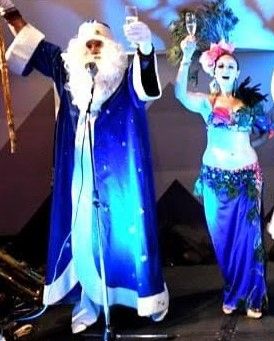Question: What do belly dancing, Santa Claus, and Christmas dinner all have in common? Answer: Turkey! The country that is, not the bird, though the fact that eating turkey for Christmas is a global tradition, even in the country of Türkiye (traditional spelling). The country of Turkey also boasts a form of belly dance that is distinctive from its Egyptian and Lebanese counterparts, although many belly dancers today perform a fusion of the styles. If you’ve seen dancers play the zils (finger cymbals), drop to their knees and extend into a full backbend, or wear bead- or coin-adorned costumes that reveal lots of torso and leg, you can thank the influence of the Turkish form. While the trademark shimmy is an Egyptian style, Turkish belly dancing--also known as ciftetelli--is more flamboyant and energetic, with hair tosses, hip gyrations, hip lifts, kicks, twirls, and leaps not withheld. Another unique Turkish contribution to the global belly dance we enjoy today is the karshilama, or 9/8 time folk dance that is often incorporated into popular routines. Also, while all forms of belly dance are open to men and women alike, Turkish belly dance has historically featured the most male dancers.
One day last December, during a mainstage rehearsal featuring Hip Expressions belly dancers and live music with the world music band “Kafkasso,” dancers were preparing for a lavish holiday show featuring many of the dance forms described above. During a break, Turkish-born band leader and lead guitarist Daryal Kafkasso blurted out: “You know guys, Santa Claus was Turkish!” His exclamation brought out immediate laughter, as most everyone assumed that Daryal--who is a constant jokester--was just pulling our legs. Santa Claus? Christmas? These December trademarks are long associated with European traditions and the Christian religion, not the Middle Eastern and mainly Muslim nation of Turkey.
But in fact, Saint Nicholas, the original name for Santa Claus, was indeed from Turkey, and many of the qualities we associate with the jolly man are historically accurate representations of this very real Turkish philanthropist and Christian bishop. Saint Nicholas was born in the third century in the city of Myra in Antalya Turkey during the height of the Roman Empire and lived there for his entire life. Many stories from various sources depict him as a generous gift-giver who would pour coins down the chimneys of poor households, where they would land in socks (stockings) hanging from the mantle to dry. He displayed a particular generosity towards those who chose to be kind, hardworking, and unselfish despite poor circumstances. While his actions were based in his devout Christian faith, these universal human qualities of compassion and giving intersect all faiths and belief systems. As such St. Nicholas is still acknowledged in Turkey, especially on the New Year. Some people even dress up like Santa Claus as a way to celebrate a new beginning and making better choices for the year ahead.
So could Mr. and Mrs. Claus have been belly dancers? Maybe they danced, but we don't find records of belly dance as a recognized art form in Turkey until the Ottoman Empire in the 14th century, one thousand years after St. Nicholas’s time. In fact, there might not have been a Mrs. Claus at all! Although the Eastern Catholic Rite allows married men to be ordained into the priesthood, only unmarried priests can become bishops. Nonetheless, considering St. Nicholas’s Turkish origins, the conjoining of Middle Eastern belly dance and Christmas makes a lot of sense, and is a great reminder that humanity shares more in common than we might realize. Dancing is a great example of this thread of our shared origins, and one that can continue well into the future. During this holiday season, when the world is steeped in needless division, this expression of our shared humanity is more important than ever.
Sources:
Saint Nicholas: Biography, Patron Saint, Feast Day & Santa
Christmas In Turkey 2024- How To Enjoy A Turkish Christmas (chasingthedonkey.com)
Christmas in Turkey: Full Guide to Turkish Christmas Traditions (unilandtours.com)
Belly dance in Turkey, Historical Roots and the Role of Men - BrightHub Education
Turkey Belly Dance: A look into this unique style of dance (2023) (theartoflivinginturkey.com)

